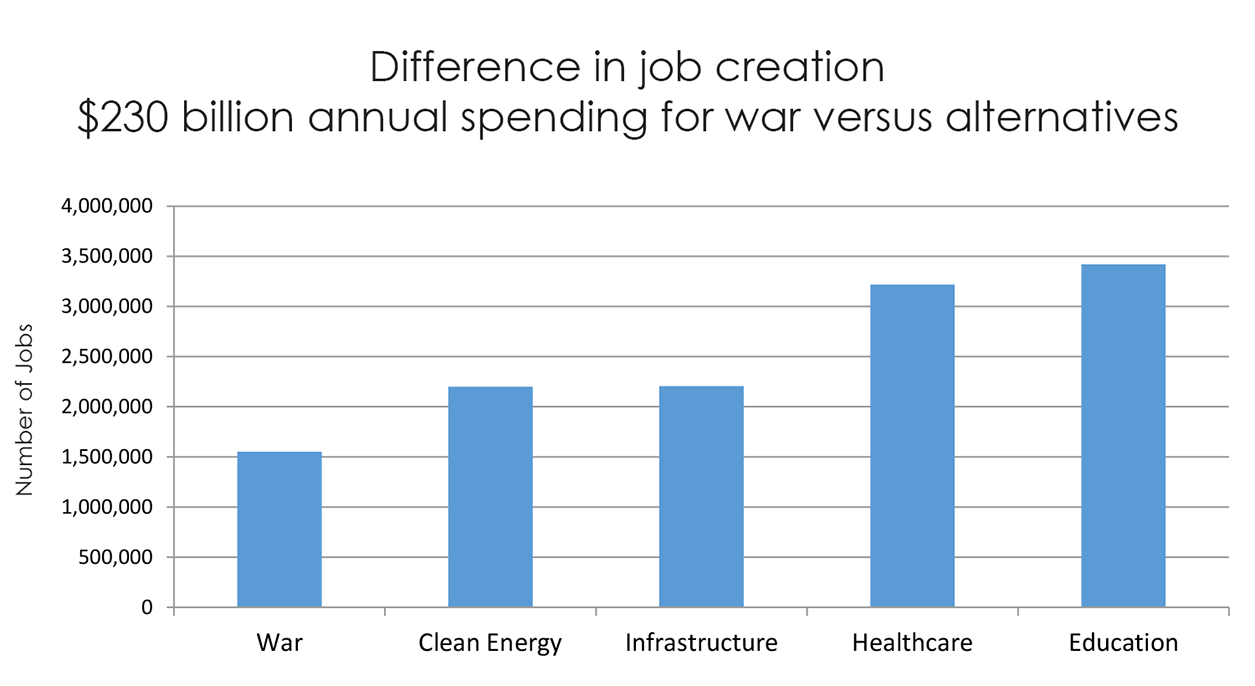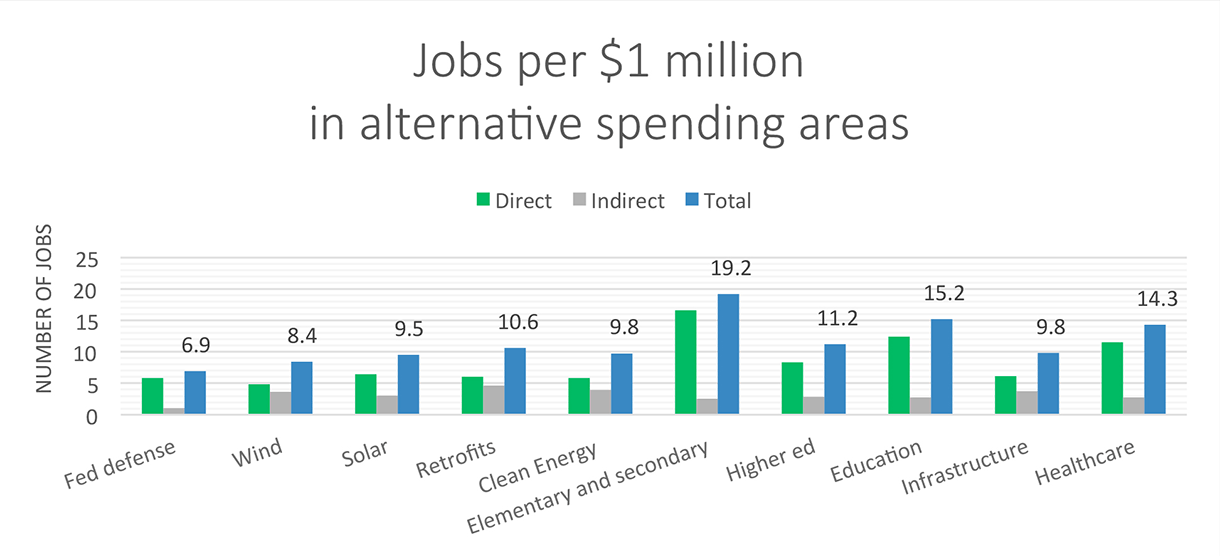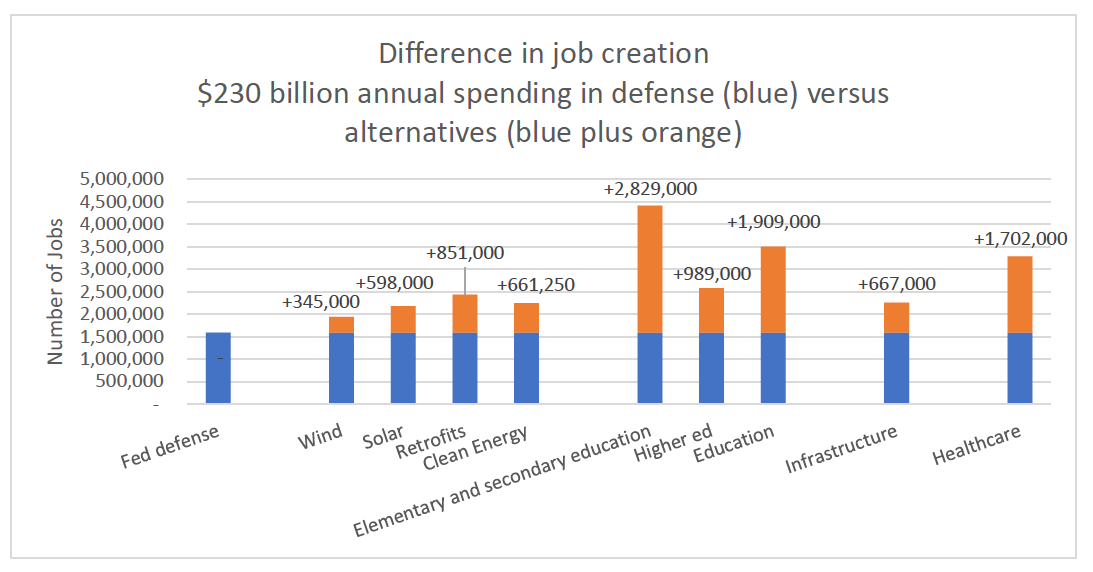How Much Money Is Spent On Veterans Career Development

PROVIDENCE, R.I. [Chocolate-brown Academy] —New inquiry by the Costs of State of war Projection based at Brown University's Watson Establish for International and Public Affairs finds that federal spending on domestic programs creates far more than American jobs and yields more wide-based benefits than war machine spending.
The written report by economist Heidi Garrett-Peltier documented how many jobs are created in a variety of domestic sectors for every million dollars of federal money spent. She compared that to the number of jobs created for every $1 million spent on defense and found that domestic spending outpaces military spending in task cosmos by 21 percent (for air current free energy development) to 178 percent (for uncomplicated and secondary education).
"The U.Due south. has a bloated war machine upkeep, and one of the reasons information technology has historically remained outsized is that defence force spending creates jobs, both in the military and in the industries that supply goods and services to the armed forces," said Garrett-Peltier, an banana inquiry professor at the Political Economy Research Found at the University of Massachusetts, Amherst. "But when we compare federal spending on defence force to the alternatives, such as wellness care, education, make clean energy or infrastructure, we observe that all of these areas create more jobs than an equivalent amount of armed services spending."
Strikingly, Garrett-Peltier constitute that investments in elementary and secondary education create nearly three times every bit many American jobs as defense spending, while health care creates about twice as many jobs. Whereas $1 million spent on defense creates half-dozen.nine direct and indirect jobs, the same amount spent on elementary and secondary education creates 19.2 jobs. $one 1000000 spent on healthcare creates 14.3 jobs.

She used an economic model called an Input-Output (I-O) model to analyze how many jobs are created for every $i million in spending, drawing on information from the U.South. Economical Census, Internal Acquirement Service tax documents, the U.South. Bureau of Labor statistics, U.S. Bureau of Economic Analysis data and other sources.
"I-O models guess the various components of the supply chain or the inputs that go into producing any proficient or service," Garrett-Peltier wrote in the study. "They also show the outputs, where each manufacture sells its goods or services to various categories of customers."
"By using an I-O model, we can estimate both the straight and indirect jobs associated with whatever type of spending," Garrett-Peltier connected. "For example, with military spending, the direct jobs are those created in the Section of Defense force whereas the indirect jobs are created in manufacturing, transportation, It and other industries that supply goods and services to the armed forces. Similarly, in education, the directly jobs are those for teachers, principals and office staff; the indirect jobs are in industries such every bit textbook publication, furniture manufacturing, electric utilities, and and then on."
That snapshot helps explain why domestic spending creates more American jobs, she noted. Starting time, some of the jobs created by defense spending "leak" overseas, whereas structure or nursing jobs created by investing in infrastructure or health care are created, and remain, in the The states.
Second, the labor intensity involved in domestic spending is greater than defense spending. Whereas the military is more dependent on equipment, and funds allocated might become to products, Garrett-Peltier said, educational activity requires people, like teachers, aides, principals and others.

The data shows that the Trump administration's proposal to increase armed forces spending by $54 billion would create fewer jobs than equivalent spending on health care, education, clean energy or infrastructure, Garrett-Peltier said, and would offer less economic benefit to the nation.
"This report is especially of import in helping put fact and public interest rather than myth or cocky-involvement at the center of discussions of the Trump administration's programme for vastly increased armed services spending," said Catherine Lutz, co-director of the Costs of State of war Project and the Thomas J. Watson, Jr. Family Professor of International Studies at Brown.
"How our tax dollars are spent should reflect our priorities," Garrett-Peltier said. "We can take a healthier, more educated population living in a cleaner surroundings at the same time that we can create more jobs. Looking at the $230 billion per year that the U.South. has been spending on strictly war-related purposes since 2001, we could have created up to three 1000000 more than jobs if we had spent these funds on various domestic priorities rather than state of war."
Editor's Note: Garrett-Peltier recently discussed the study on the Watson Establish's Trending Globally podcast, available online here.
Source: https://www.brown.edu/news/2017-05-25/jobscow
Posted by: perrytworiblest.blogspot.com

0 Response to "How Much Money Is Spent On Veterans Career Development"
Post a Comment